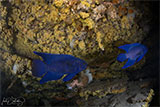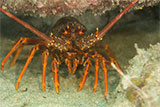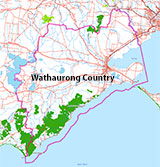Spec Reef
![]() Reef Dive |
Reef Dive | ![]() Boat access
Boat access
![]()
![]()
![]()
![]()
![]()
![]()
![]()
![]()
Depth: 22 m (72 ft) to 60 m (197 ft)
Spec Reef (aka Spectacular Reef) is part of the former Yarra River bed and lies in the South Channel, Port Phillip, Victoria and is therefore subject to shipping traffic. The area is quite large and offers many different dive sites. All dives are characterised by a spectacular wall which has large undercuts housing Southern Rock Lobster (aka Crayfish), Southern Blue Devil, beautiful soft corals, and an abundance of other life including Bastard Trumpeter, Leather Jackets, the Rosy Wrasse, and inquisitive White-ear, along with literally thousands of small baitfish.
Spec Reef is very aptly named. The scenery, rock formations, the sheer drop-offs and the most abundant fish life in the Bay, make it a special place.
On days of good visibility you will understand why this area is called Spectacular Reef. The terrain is quite dramatic with large deep ledges. It can only be dived on the slack water when there is no shipping as it is right in the middle of the channel. This makes another elusive site but well worth the effort. It starts in 15 metres and runs East to West with deeper water down to over 33 metres to the South. The current here is not a strong as in other places, which means that this dive can be done on either of the slack waters.
Spec Reef has an unusual combination of huge undercuts and sheer drop offs. The sheer sides of the reef have fantastic overhangs and lovely colours in the sponge life. The area is big on sponges and very, very fishy. This is truly one of the prettiest dives in the bay — in fact it's spectacular.
Divers have the opportunity to catch Southern Rock Lobster (aka Crayfish) at this dive site. Remember your catch bag, current Victorian Recreational Fishing Licence, rock lobster measure, and cray tags. Once you get back to the dive boat, or shore, make sure you clip the tail and tag your Crayfish as per Fisheries requirements. Please abide by all current fishing regulations if you intend to catch crays. See article-catching-crayfish for practical cray hunting advice from The Scuba Doctor, plus melbourne-cray-dives for a list of other crayfish dive sites near Melbourne. For tips on cooking your Crays, please see article-cooking-crayfish.
Finding the Spec Reef
Over the years we've been provided with different GPS marks for the Spec Reef. The GPS marks we know of in circulation for the Spec Reef are:
- GPS
Latitude: 38° 17.294′ S (38.288233° S / 38° 17′ 17.64″ S)
Longitude: 144° 39.946′ E (144.665767° E / 144° 39′ 56.76″ E) - Geoff Rodda:
Latitude: 38° 17.304′ S (38.2884° S / 38° 17′ 18.24″ S)
Longitude: 144° 40.068′ E (144.6678° E / 144° 40′ 4.08″ E)
178 m, bearing 95°, E
Traditional Owners — This dive site is in the traditional Country of the Wathaurong (Wadda-Warrung) people of the Kulin Nation. This truly ancient Country includes the coastline of Port Phillip, from the Werribee River in the north-east, the Bellarine Peninsula, and down to Cape Otway in the south-west. We wish to acknowledge the Wathaurong as Traditional Owners. We pay respect to their Ancestors and their Elders, past, present and emerging. We acknowledge Bunjil the Creator Spirit of this beautiful land, who travels as an eagle, and Waarn, who protects the waterways and travels as a crow, and thank them for continuing to watch over this Country today and beyond.
Spec Reef Location Map
Latitude: 38° 17.294′ S (38.288233° S / 38° 17′ 17.64″ S)
Longitude: 144° 39.946′ E (144.665767° E / 144° 39′ 56.76″ E)
Datum: WGS84 |
Google Map
Added: 2012-07-22 09:00:00 GMT, Last updated: 2021-07-16 21:51:20 GMT
Source: GPS
Nearest Neighbour: North Wall, 245 m, bearing 251°, WSW
Depth: 22 to 60 m.
Dive only on: SWF, SWE.
[ Top ]
DISCLAIMER: No claim is made by The Scuba Doctor as to the accuracy of the dive site coordinates listed here. Should anyone decide to use these GPS marks to locate and dive on a site, they do so entirely at their own risk. Always verify against other sources.
The marks come from numerous sources including commercial operators, independent dive clubs, reference works, and active divers. Some are known to be accurate, while others may not be. Some GPS marks may even have come from maps using the AGD66 datum, and thus may need be converted to the WGS84 datum. To distinguish between the possible accuracy of the dive site marks, we've tried to give each mark a source of GPS, Google Earth, or unknown.




